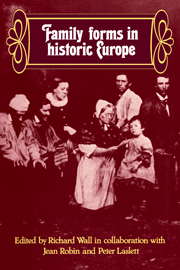Book contents
- Frontmatter
- Contents
- List of contributors
- Preface
- 1 Introduction
- 2 Two kinds of pre-industrial household formation system
- 3 ‘A large family: the peasant's greatest wealth’: serf households in Mishino, Russia, 1814–1858
- 4 The peasant family as an economic unit in the Polish feudal economy of the eighteenth century
- 5 The familial contexts of early childhood in Baltic serf society
- 6 Estonian households in the seventeenth and eighteenth centuries
- 7 Family and familia in early-medieval Bavaria
- 8 The property and kin relationships of retired farmers in northern and central Europe
- 9 Pre-industrial household structure in Hungary
- 10 The reconstruction of the family life course: theoretical problems and empirical results
- 11 The changing household: Austrian household structure from the seventeenth to the early twentieth century
- 12 Does owning real property influence the form of the household? An example from rural West Flanders
- 13 The evolving household: the case of Lampernisse, West Flanders
- 14 The composition of households in a population of 6 men to 10 women: south-east Bruges in 1814
- 15 The importance of women in an urban environment: the example of the Rheims household at the beginning of the Industrial Revolution
- 16 The household: demographic and economic change in England, 1650–1970
- 17 Family and household as work group and kin group: areas of traditional Europe compared
- References
- Index
8 - The property and kin relationships of retired farmers in northern and central Europe
Published online by Cambridge University Press: 05 November 2011
- Frontmatter
- Contents
- List of contributors
- Preface
- 1 Introduction
- 2 Two kinds of pre-industrial household formation system
- 3 ‘A large family: the peasant's greatest wealth’: serf households in Mishino, Russia, 1814–1858
- 4 The peasant family as an economic unit in the Polish feudal economy of the eighteenth century
- 5 The familial contexts of early childhood in Baltic serf society
- 6 Estonian households in the seventeenth and eighteenth centuries
- 7 Family and familia in early-medieval Bavaria
- 8 The property and kin relationships of retired farmers in northern and central Europe
- 9 Pre-industrial household structure in Hungary
- 10 The reconstruction of the family life course: theoretical problems and empirical results
- 11 The changing household: Austrian household structure from the seventeenth to the early twentieth century
- 12 Does owning real property influence the form of the household? An example from rural West Flanders
- 13 The evolving household: the case of Lampernisse, West Flanders
- 14 The composition of households in a population of 6 men to 10 women: south-east Bruges in 1814
- 15 The importance of women in an urban environment: the example of the Rheims household at the beginning of the Industrial Revolution
- 16 The household: demographic and economic change in England, 1650–1970
- 17 Family and household as work group and kin group: areas of traditional Europe compared
- References
- Index
Summary
Introduction
The structure of modern industrial societies shows an ageing population. In most countries in Europe there are more old age pensioners than ever before, and the proportion of people who have retired from the labour market because of age is steadily growing. Even in countries, like those of Scandinavia, where the proportion of aged persons is so high already that it cannot increase, there will be a great expansion in the number of the very old, that is those over 80 years of age, continuing into the next century.
This situation leads to difficulty in planning ahead for payment of old-age pensions based on social security funds deducted from the working population. In addition, traditional ways of coping with the problems of the very old by putting them into special institutions or hospitals have been extremely costly. There is, therefore, a considerable interest in alternative solutions to the problems of old age; a search for cheaper but perhaps even more humane ways of treating the elderly. Some social workers have tried to stimulate sons or daughters to take the old people back to their homes and build some sort of extended family. In countries like the United States, where institutional care for the elderly has not been given priority, more than one-third of all aged single people live with relatives, usually adult children.
- Type
- Chapter
- Information
- Family Forms in Historic Europe , pp. 249 - 280Publisher: Cambridge University PressPrint publication year: 1983
- 22
- Cited by



